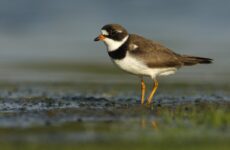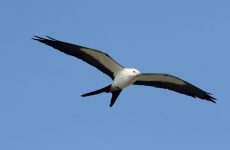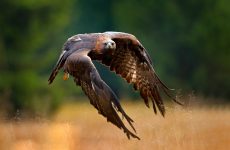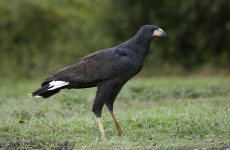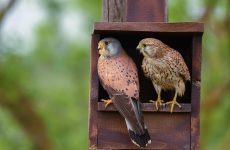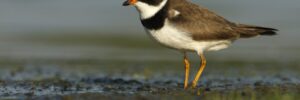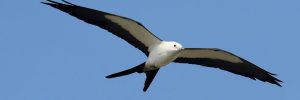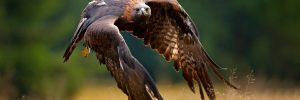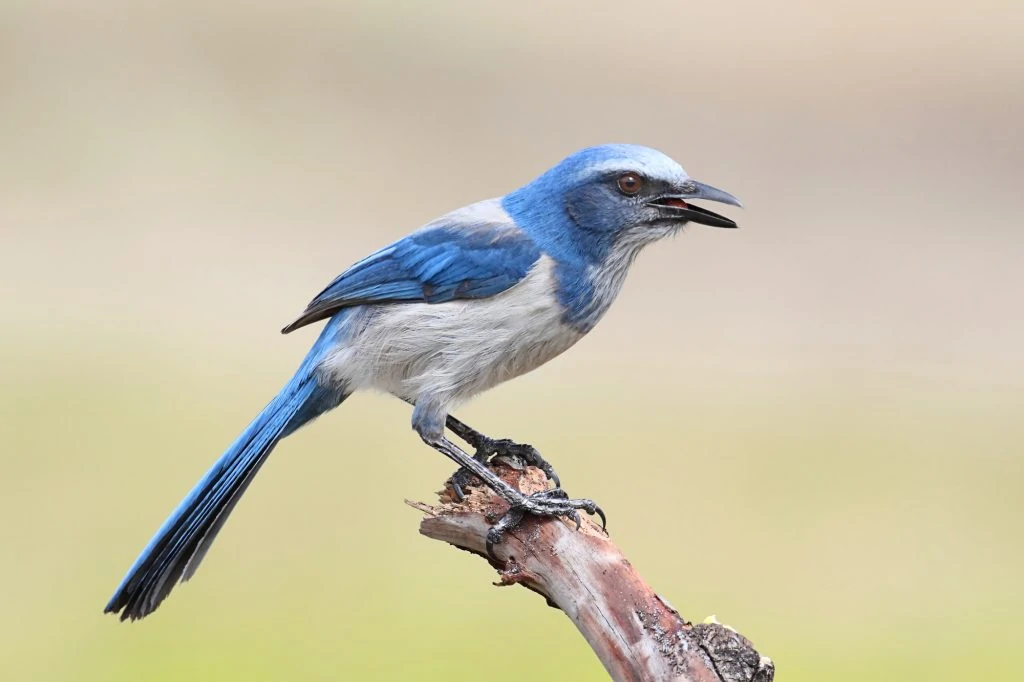
These highly intelligent and widely distributed birds called corvids or crows are known as the smartest birds and include colorful jays, large ravens, magpies, nutcrackers, and crows.
Crows are among the most intelligent of birds and show skills equivalent to a 7-year-old child. They make tools to get bugs out of crevices and even to fish with!
Crows are omnivores and will eat whatever is available and this can cause problems when they target trash and it can give them a bad reputation. They are also associated with death and bad omens in folklore.
There are 6 types of crows in Florida and these include Blue Jays, Fish Crows, American Crows, Florida Scrub-Jays, Black-billed Magpies, and Black-throated Magpie-Jays.
Love them or hate them they are fascinating birds to watch and so check out all the corvids in Florida.
6 Crows in Florida:
1. Blue Jay
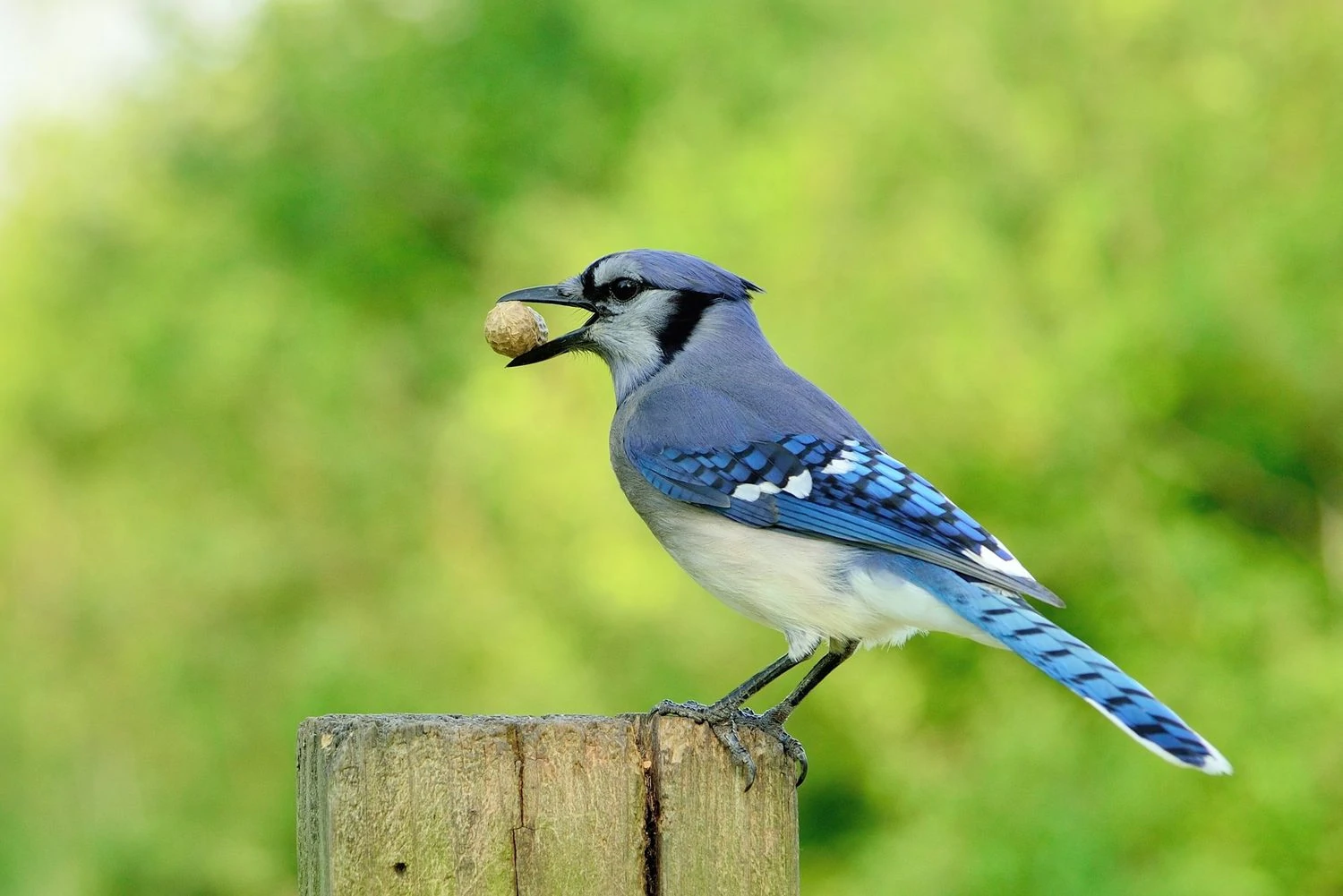
Blue Jays are very common in Florida and are spotted in the state all year. They are recorded in 36% of summer checklists and 29% of winter checklists submitted by bird watchers for the state.
Blue Jays are common large songbirds with a blue upright crest, blue and black backs, and white undersides.
- Cyanocitta cristata
- Length: 9.8-11.8 in (25-30 cm)
- Weight: 2.5-3.5 oz (70-100 g)
- Wingspan: 13.4-16.9 in (34-43 cm)
Blue Jays live in eastern US states and Southern Canada all year. Some birds will migrate west for winter but not very frequently.
They are noisy birds that travel in family groups eating acorns when available. They can be found in forests, especially near oak, as they eat acorns. They can also be found in backyards near feeders.
As well as acorns, they eat insects, nuts and seeds, and grain. They may also take eggs from nests or take nestlings.
Blue Jay sounds: They usually make a variety of quite harsh calls using clicks, peeps, ‘caws’, and whistles. Blue Jays also have a gentle fluted song during courtship.
Blue Jays are large birds and prefer to fly in, grab a peanut or sunflower seed and take it away to feed. They prefer platform or tray feeders to make it easy to make a quick exit.
Attract Blue Jays to your backyard with peanuts, sunflower seeds, and suet on tray feeders or hopper feeders on a post. They will also enjoy a birdbath.
Fun fact: Blue Jays will play with shiny objects such as aluminum or bottle caps, and they will carry them around, dropping them and picking them up.
2. Fish Crow
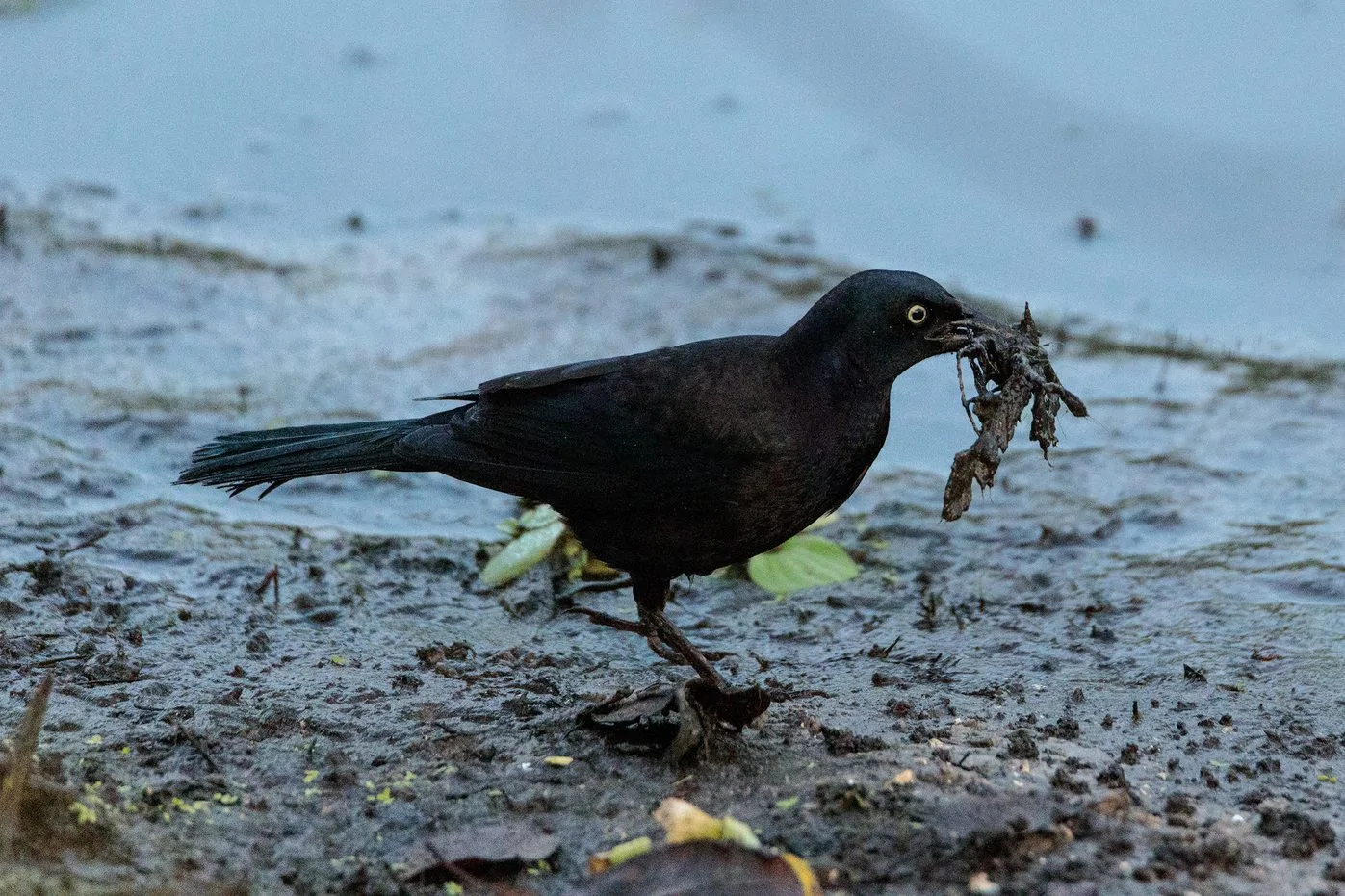
Fish Crows are spotted in Florida all year but their numbers increase from March to mid-July. They appear in 33% of summer checklists and 21% of winter checklists.
Fish Crows look the same as American Crows, with all black glossy coloring and strong, sturdy bodies. Only their calls are different. They have slightly rough throat feathers, which they puff out when calling. Males and females look the same.
- Corvus ossifragus
- Length: 14.2-15.8 in (36-40 cm)
- Weight: 6.9-11.6 oz (195-330 g)
- Wingspan: 33.1 in (84 cm)
Fish Crows are resident along the east coast from Texas up to Maine. They will occasionally move short distances in winter.
You can find Fish Crows near water, including beaches, rivers, and marshes. Like most crows, they are also often found near humans as they will eat most things, not just fish as their name would suggest. Grain, fruit, eggs, and baby birds, are all on the menu, as well as crabs and other marine life.
Fish Crow sounds: A typical crow ‘caw,’ but more nasal than the American Crow.
Nests of Fish Crows are in trees or mangroves and are made from bundles of sticks and filled with mud and softer material such as moss, pine needles, and bark.
They lay 2 – 6 eggs, and these take around two and a half weeks to hatch and a further four to five weeks to fledge.
Fun Fact: Fish Crows form massive, noisy flocks in their hundreds of thousands in winter.
3. American Crow
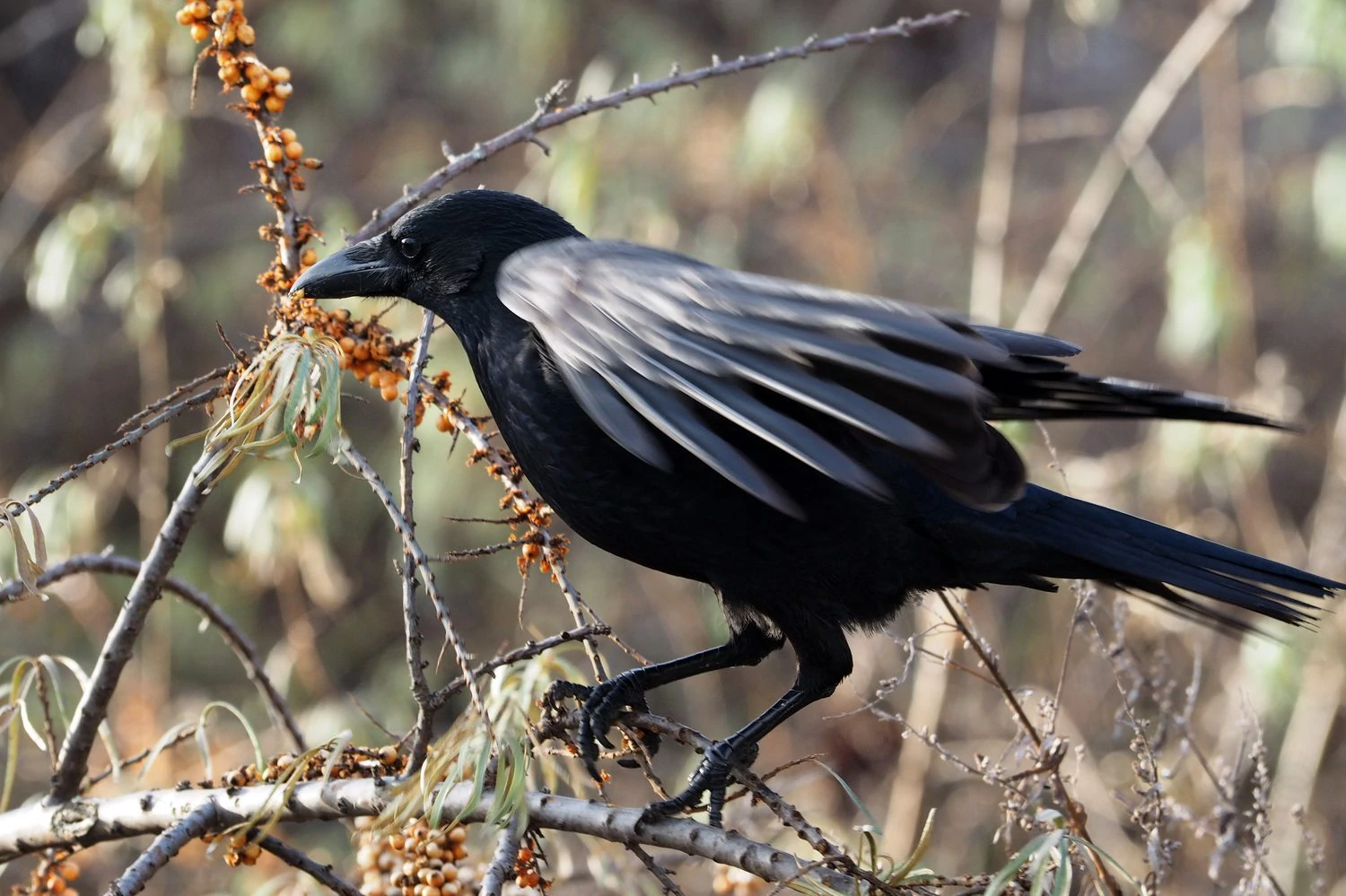
American Crows are common and found all year in Florida. They are spotted in up to 17% of summer and winter checklists for the state.
American crows are large all-black birds, including their legs and bills. They have slightly glossy feathers.
- Corvus brachyrhynchos
- Length: 15.8-20.9 in (40-53 cm)
- Weight: 11.2-21.9 oz (316-620 g)
- Wingspan: 33.5-39.4 in (85-100 cm)
American Crows are residents all year in the lower 48 and the Pacific Coast of Canada and Alaska. Those that breed in Canada and the northern Midwest migrate south for winter.
They are common birds that can be found in most habitats, including treetops, woods, fields, beaches, or towns.
They eat most things and usually feed on the ground, eating earthworms, insects, seeds, and fruit. They also eat fish, young turtles, mussels, and clams and will even eat eggs and nestlings of many species of birds.
American Crow Sounds: They make a hoarse, cawing sound
Nests of American Crows are usually high up in conifers and oak and are made from sticks. They lay 3 – 6 eggs, and these take just under three weeks to hatch and a further five weeks to fledge.
Attract American Crows to your backyard by scattering peanuts, but they can become a nuisance as attracted by garbage or pet food if left out.
Fun Fact: American Crows gather in large numbers of up to two million crows in winter to sleep in communal roosts.
4. Florida Scrub-Jay

Florida Scrub-Jays are endemic and vulnerable species in Florida but they are spotted here all year. They occur in 1% of summer and winter checklists.
Florida Scrub-Jays are blue, with gray bellies, backs, and foreheads. They have long blue tails and do not have a crest on their heads. Males and females look the same, but juveniles are grayer and have gray heads.
- Aphelocoma coerulescens
- Length: 9.1-11.0 in (23-28 cm)
- Weight: 2.3-3.3 oz (66-92 g)
- Wingspan: 13.0-14.2 in (33-36 cm)
As the name would suggest, Florida Scrub-Jays are found in Florida, and they do not migrate. They are endemic to Florida, meaning they are only native here.
You can find Florida Scrub-Jays in relatively open scrubby areas that are sandy and contain oak scrub. They will be found on the ground looking for insects and berries, and they also eat acorns. They are, however, listed as vulnerable on the ICUN Red List.
Florida Scrub-Jay sounds: They make quite harsh calls and spend a lot of time calling to each other.
Nests of Florida Scrub-Jays are usually in oak trees or shrubs, and they form cooperative flocks, which include young from the previous year. These flocks help protect from predators and feed their young. The offspring then find a territory of their own.
Fun fact: Florida Scrub-Jays break acorns apart by holding them in their feet and using their bills to hammer on the acorn until it breaks open.
5. Black-billed Magpie
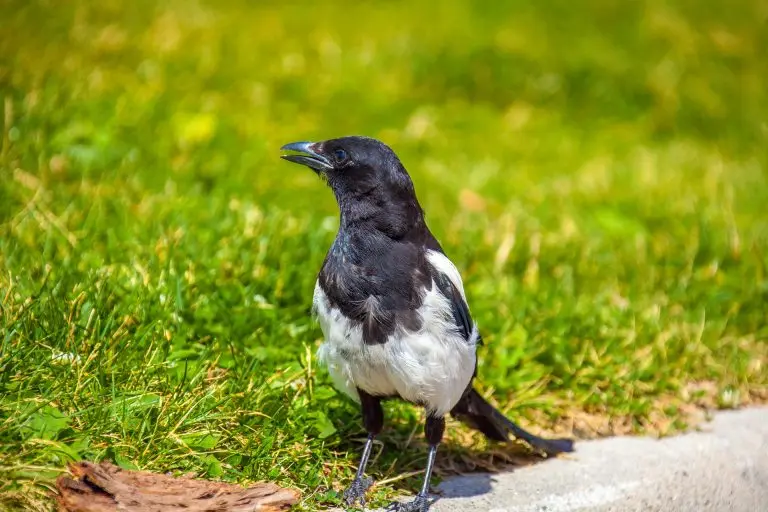
Black-billed Magpies are accidental species in Florida. They are extremely rare in the state and were only spotted here a long time ago.
Black-billed Magpies, usually just called Magpies, are black and white birds that are noisy. They have long tails and blue-green iridescent flashes in the wing and tail. Males are up to 25% heavier than females.
- Pica hudsonia
- Length: 17.7-23.6 in (45-60 cm)
- Weight: 5.1-7.4 oz (145-210 g)
- Wingspan: 22.1-24.0 in (56-61 cm)
Black-billed Magpies live in northwestern US states and western Canada, and the coast of Alaska. They do not migrate.
You can find them walking on the ground in meadow and grasslands or other open areas feeding on fruit and grain, beetles, and grasshoppers. They have also been known to kill small mammals such as squirrels and voles and raid bird nests for eggs or nestlings and even carrion.
Black-billed Magpie sounds: A series of harsh calls and also a scream.
Nests of Black-billed Magpies are a messy ball-shaped collection of twigs with a neat cup of mud and soft material on the inside. They lay 6 – 7 eggs, and these take around three weeks to hatch and fledge a further 3 – 4 weeks.
You can attract Black-billed Magpies to your backyard with platform and suet feeders with black oil sunflower seeds, peanuts, fruit, suet, millet, and milo.
Fun Fact: A gathering of magpies calling around one of their dead is called a funeral.
6. Black-throated Magpie-Jay
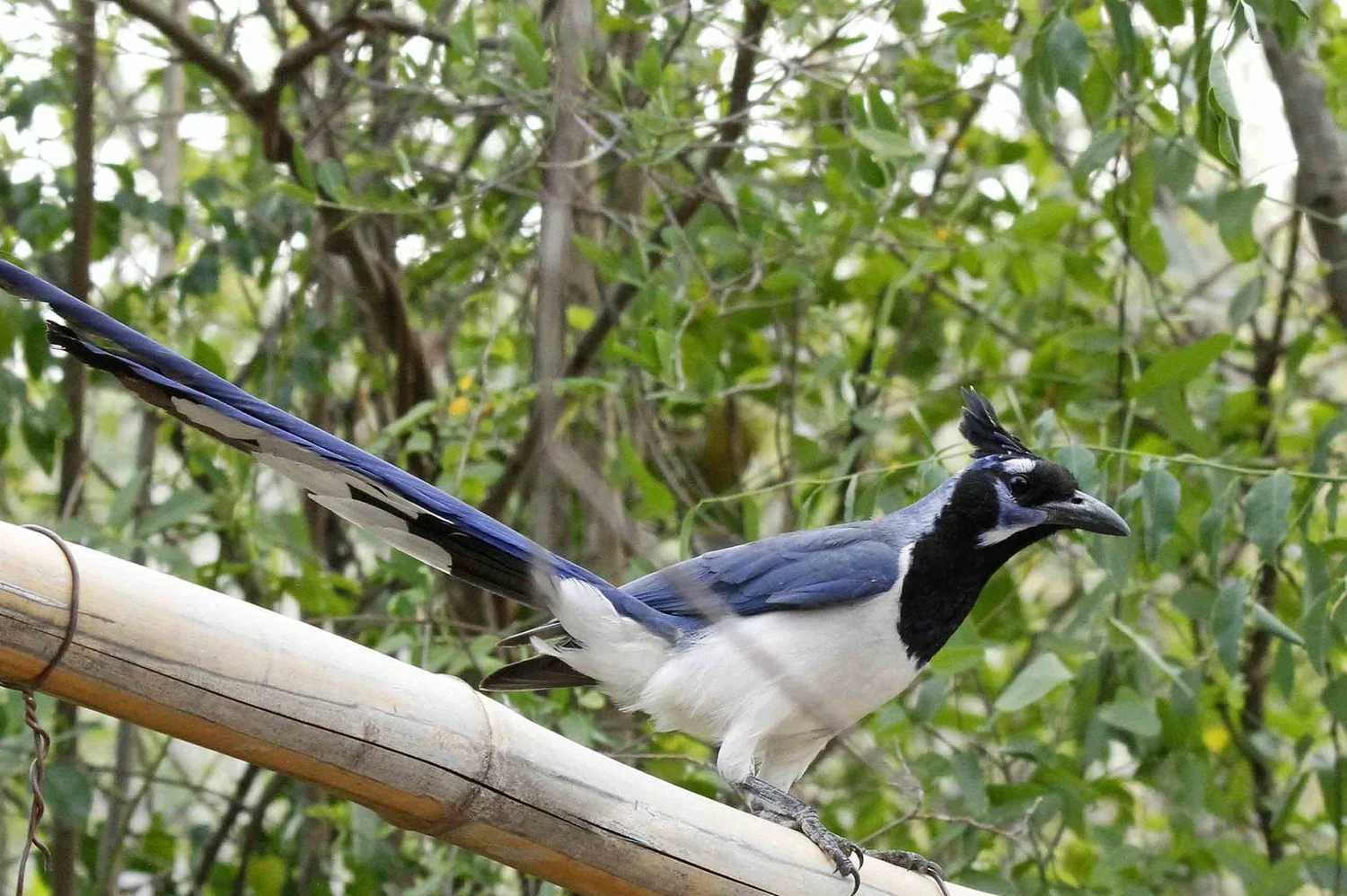
Black-throated Magpie-Jays are considered accidental species in Florida, and according to records, they have only been spotted around Dade City in 2008.
The striking Black-Throated Magpie Jay is a large, long-tailed bird. It has a conspicuous black crest and throat, a patch of blue on its eyebrows and under the eye, blue wings, a white-tipped tail, and a white underside.
In the south of their range, their throats are more white with a thinner black band.
- Calocitta colliei
- Length: 23 – 30 in (58.5 – 76.5 cm)
- Weight: 8 – 9 oz (225 – 251 cm)
You can find Black-throated Magpie Jays around tropical lowland forests, plantations, and partially open areas with tall trees and hedges. They are not particularly fond of humid woodlands, though.
Typical of a crow family, a Black-throated Magpie Jay eats both plants and animals. It loves seeds and nuts but is also known to eat insects and other smaller birds.
Black-throated Magpie-Jay sounds:
Black-throated Magpie-Jays nest is usually created with sticks and twigs but lined with some soft material, and they lay up to seven eggs.
Fun Fact: Black-throated Magpie Jay eats standing up. One foot is used to hold on to the food while the other foot puts food in its mouth.

